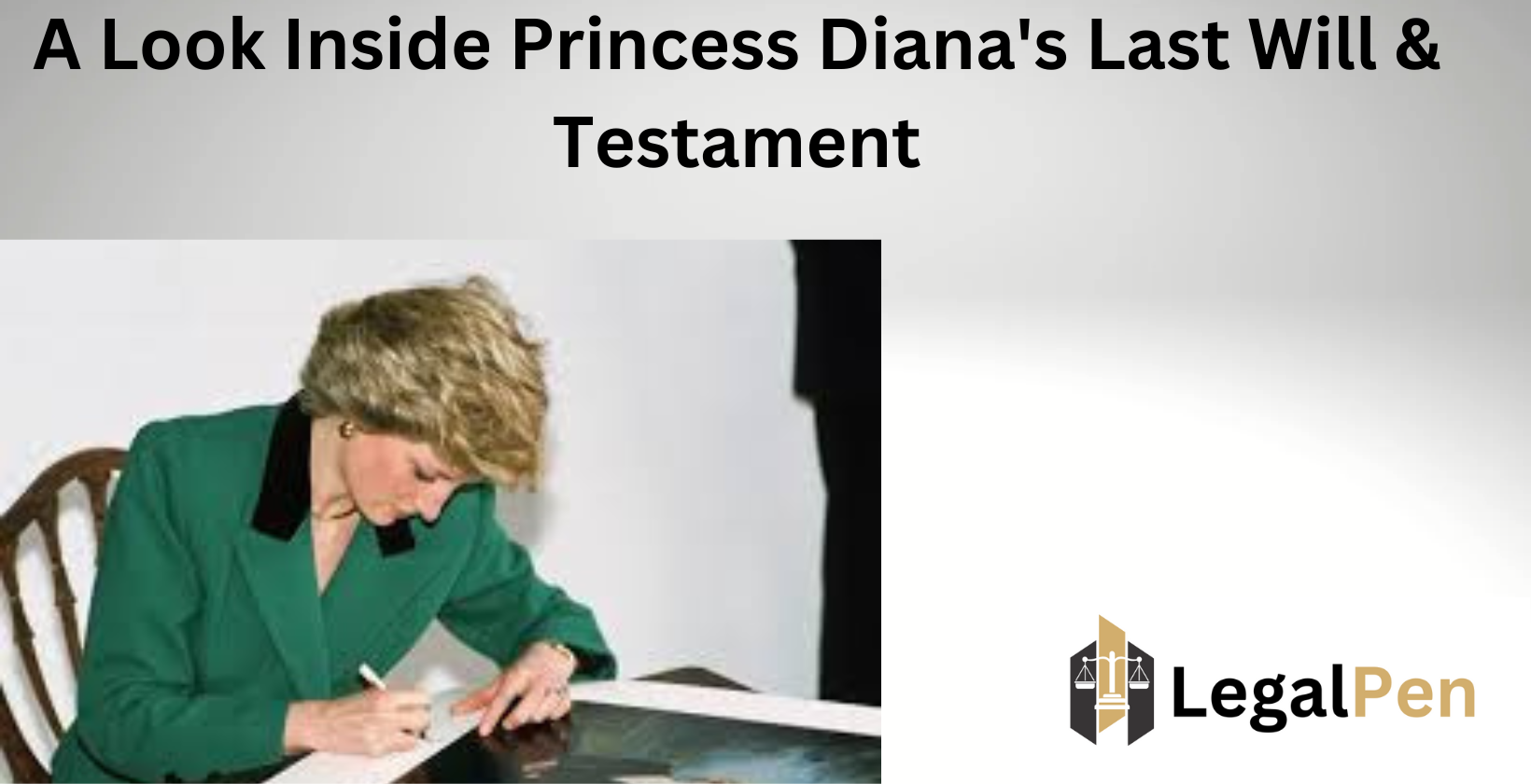Princess Diana’s last will and testament offer a fascinating insight into the life and legacy of one of the world’s most beloved figures. The document outlines the value of her estate, the individuals and organizations who benefited from her legacy, and specific bequests of personal items that held sentimental and cultural significance. The will reveals her careful planning for her sons, Princes William and Harry, and other beneficiaries, while highlighting contentious decisions that led to family disputes and legal debates. These details paint a picture of Diana’s enduring impact and the challenges of managing a high-profile estate.
How Much Was Princess Diana’s Estate Worth?
Princess Diana’s estate was worth approximately £21 million ($36 million USD) before taxes and legal fees. After inheritance taxes and other deductions, the net value was reduced to about £12.9 million ($22 million USD).
Who Was Included In Princess Diana’s Will?
Princess Diana’s will primarily included her two sons, Princes William and Harry, as the main beneficiaries of her estate. They inherited the majority of her financial assets and personal belongings. In addition to her sons, Diana named her 17 godchildren as beneficiaries, leaving each of them a small sentimental gift or keepsake from her estate. Trusted members of her household staff, including her butler and other close associates, were also included in the will, receiving tokens of appreciation for their service and loyalty. The will reflected Diana’s care and thoughtfulness in providing for both her immediate family and the individuals who were meaningful in her life.
Who Inherited Under Princess Diana’s Will?
Princes William and Harry were the primary inheritors under Princess Diana’s will, receiving the bulk of her estate, which included her financial assets, jewelry, and other valuable personal belongings. Diana’s will specified that her sons would gain access to these inheritances upon reaching the age of 30, ensuring their long-term financial stability and preserving her legacy.
Additionally, her 17 godchildren were included in the will, each receiving a sentimental keepsake, such as a piece of jewelry, as a gesture of her affection and thoughtfulness. Diana’s household staff and close associates were not forgotten, with some receiving small bequests as tokens of gratitude for their service and loyalty. This comprehensive approach to her will highlighted Diana’s care for both her immediate family and those who had meaningful roles in her life.
What Did the Will Include?
The will included a wide range of Princess Diana’s assets and possessions. These encompassed her financial holdings, personal belongings, jewelry, and family heirlooms. Specific items, such as her iconic jewelry collection and personal mementos, were earmarked for her sons, Princes William and Harry. Diana also set aside keepsakes for her 17 godchildren, ensuring they received sentimental gifts that reflected her connection to each of them.
Other personal items included her wardrobe, furniture, letters, and photographs, many of which held significant sentimental value. Diana’s estate was structured to provide for her sons while recognizing close family members, friends, and staff with thoughtful bequests. The will demonstrated Diana’s meticulous planning to honor her relationships and safeguard her legacy.
What Happened To Princess Diana’s Iconic Jewelry And Wedding Dress?
Princess Diana’s iconic jewelry and wedding dress were left to her sons, Princes William and Harry, as part of her will. The jewelry collection, which included her famous sapphire and diamond engagement ring, was intended to be shared between them. The engagement ring was later given by Prince William to Kate Middleton when he proposed, adding sentimental value to the piece.
Her wedding dress, a symbol of her legacy, was entrusted to her sons as well. It was kept in safekeeping and eventually displayed in exhibitions before being returned to Princes William and Harry on their 30th birthdays. These items remain cherished pieces of Diana’s memory and are significant parts of her enduring legacy.
Controversy Surrounding Princess Diana’s Estate Plan
The controversy surrounding Princess Diana’s estate plan primarily stemmed from changes made after her death. Diana’s will appointed her mother, Frances Shand Kydd, and her sister, Lady Sarah McCorquodale, as executors. They implemented a “variation” to the will, which deferred certain distributions and altered how assets were allocated.
One notable point of contention involved the handling of Diana’s personal belongings, including her jewelry and sentimental items. While her will specified that these were to be distributed immediately to beneficiaries such as her sons and godchildren, the executors delayed this process, sparking legal debates and public criticism.
Additionally, the use of discretionary funds to manage certain aspects of the estate led to questions about whether Diana’s explicit wishes were fully honored. These actions, while legally permissible, drew scrutiny and contributed to ongoing discussions about respecting the intent of high-profile wills.
Always Go With a Trust and Will
Using a trust and will together offers a comprehensive approach to estate planning. A will ensures your final wishes are documented and your assets are distributed according to your instructions. However, a trust can provide additional benefits, such as avoiding probate, ensuring privacy, and offering greater control over how assets are managed and distributed after your passing.
A trust allows for the seamless transfer of property and other assets to beneficiaries, often reducing legal costs and delays. It can also protect assets from creditors and ensure they are used for specific purposes, such as funding education or healthcare.
Combining a trust and will ensures that all aspects of your estate are addressed. For example, a “pour-over” will can transfer any remaining assets into a trust, ensuring nothing is left unmanaged. This combination provides peace of mind and reduces the risk of disputes or complications for your loved ones.
How Did Princess Diana’s Will Influence Modern Estate Planning Practices?
Princess Diana’s will influenced modern estate planning practices by highlighting the importance of clarity, flexibility, and the use of trusts to manage high-profile or complex estates. The publicized controversy surrounding her will exposed challenges that can arise from traditional estate planning methods and served as a case study for improving practices.
Key Influences on Modern Practices:
- Clarity in Asset Distribution:
Diana’s will, though specific in many areas, faced disputes due to posthumous modifications by her executors. Modern estate planning now emphasizes precise language to prevent ambiguity and ensure the testator’s wishes are respected. - Role of Trusts in Avoiding Probate:
Her estate underwent probate, which subjected it to public scrutiny and delays. This highlighted the advantage of using trusts to maintain privacy, streamline asset distribution, and avoid prolonged probate processes. - Incorporating Digital Legacies:
While Diana’s will predated the digital era, her case underscored the need for modern wills to include provisions for managing digital assets, such as online accounts and personal files. - Tax Planning Strategies:
The significant reduction in her estate’s value due to inheritance taxes revealed the need for better tax planning strategies. Today, estate planners often incorporate trusts and charitable donations to minimize tax burdens. - Executor Accountability:
The changes made to Diana’s will by her executors raised questions about their discretion and accountability. Modern practices now stress appointing executors who align with the testator’s values and ensuring oversight mechanisms are in place.
Meet the Author
Annie L – Distinguished linguist at LegalPen
Annie is a distinguished linguist at LegalPen, bringing a unique blend of legal expertise and linguistic precision to her work. She earned her Juris Doctor degree from Yale University in New Haven, Connecticut, attending on a prestigious Law Faculty Merit Scholarship. At Yale, Annie showcased her exceptional skills by serving as an editor on the Yale Law Review.
Upon graduating, Annie gained invaluable experience through a two-year appellate clerkship at a renowned law firm in Connecticut. During her time in law school, she honed her research and writing abilities as a research assistant and writer for various legal firms. Annie’s deep understanding of legal language and her attention to detail make her an invaluable asset to LegalPen.



